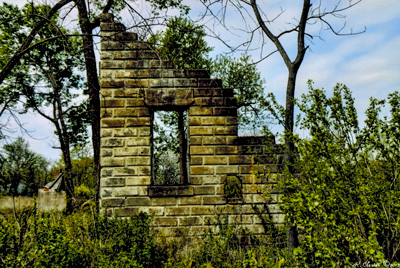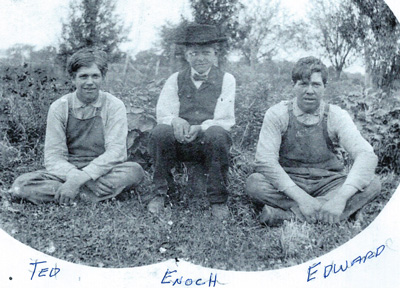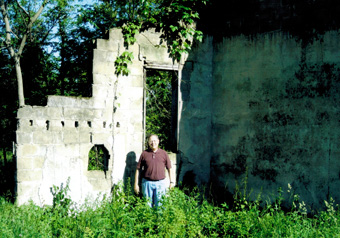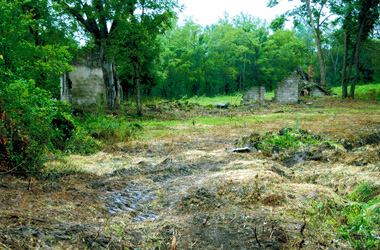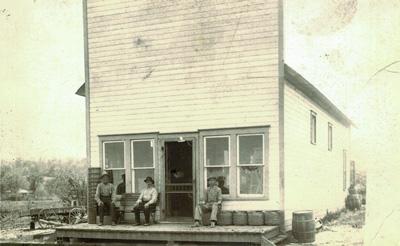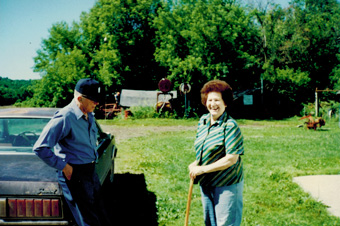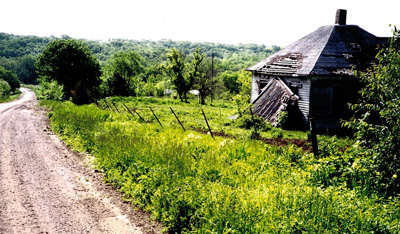
http://www.buxtoniowa.com • Consol, Haydock & Buxton Iowa, USA • 1871 - 2014
The Sampson Movie Theater in Consol, Iowa
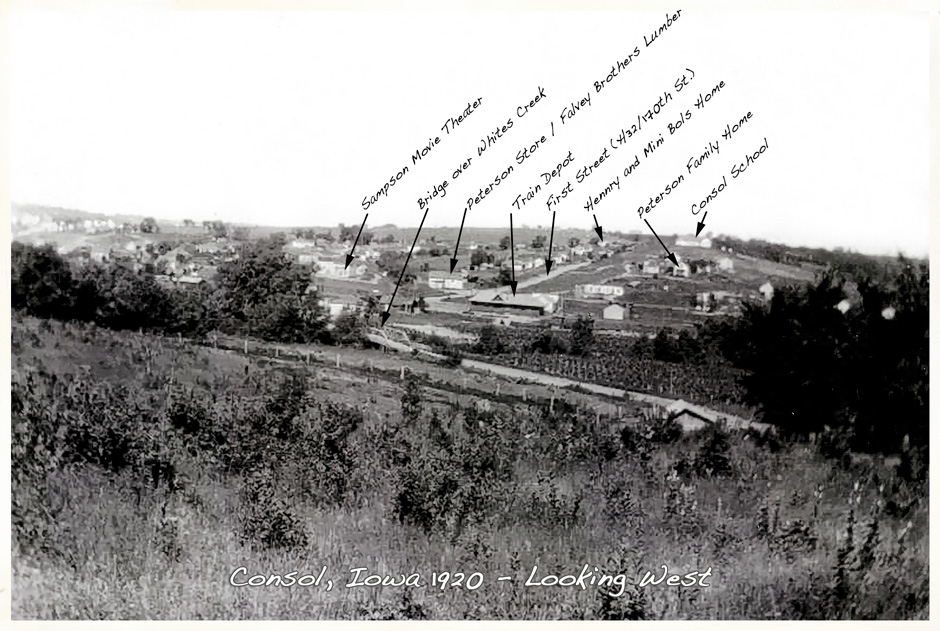
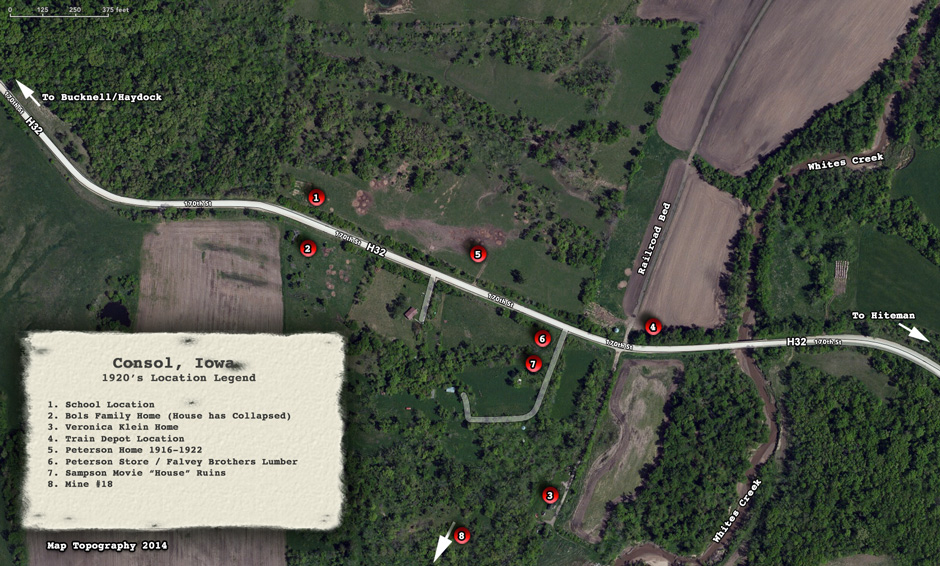
Monroe County News
Vol. 125 No. 27 Teusday July 6, 2010
"Coal Mining Town Rich in History"
By: Gordon Peterson
Monroe County’s abandoned coal camps and and mines are family history for thousands of us who have our roots in the area. Over the past Memorial Day weekend, I met cousins Carl Blomgren from Kansas City and Gary Johnson from South Dakota in Albia. We visited the coal camps of Buxton, Consol, Bucknell and Haydock to continue our research into our families’ lived as they were some 100 plus years ago.
Our family migrated from Sweden starting in the early 1880s and settles in Muchakinock, close to Given south of Oskaloosa. They followed the movement of the coal camps from Muchakinock to Buxton, to Consol, to Bucknell/Haydock and Rex 5. Unlike most residents of the coal camps, once mines 18 and 19 were closed in 1927 and mine 20 never opened, some of our family members remained in the area as grocers and farmers. Some even had small coal mines in their backyards, so to speak. My grandfather, David Peterson (DA), built “Casey-like” convenient gas stations along Highway 34 in Georgertown and Melrose Corners. The stations were built using the lumber from the miners’ homes that were sold in Bucknell/Haydock for $50 per house. After World War II, my grandfather farmed much of the land that was once Buxton’s East Swedetown.
My cousin, Gary, was very interested in exploring Consol and the movie hall that his grandfather, Ed Sampson, and Ed’s brother, Ted, built and ran in Consol. The brick walls of the Movie Hall, as it was called then, are still standing along County Road H32 (160th Street). Until last year, the walls of the theater were virtually hidden by trees and shrubs and not visible from H32. The movie hall’s walls and the remnants of the Boles’ home, at the top of a schoolhouse hill to the west are basically the only landmarks remaining of the Consol coal camp.
The bridge over White Creek and the railroad beds are still in evidence, but outside of that Consol is gone with the coal dust. The lane to Veronica Kline’s home before she died used the old railroad bed that ran south to mines 18 and 19. Thousands of tons of coal were once transported over that railroad bed. The movie hall paralleled the railroad track a block or so to the west. I often wonder if a train passing through town would have disrupted a movie in progress.
According to Ted Sampson’s diary of that era, he and his brother Ed started building the theater on April 11, 1918 with the delivery of two loads of sand to be used in making the walls. However, a week later Ted recommenced his notice from the war department. It is assumed that his brother Ed completed and ran the movie hall until Ted was discharged from the service in June 11, 1919. Ted’s grandson, Gene, whose widow, Annette, and their son Mark from Saint Paul, Minn. area, were on the Monroe County tour last summer. They have provided a copy of Ted’s diary to the Museum in Albia. The diary is and exercise in briefness — Ted would have made a great “Twitterer”. He noted, “DA was robbed” when my grandfather was robbed of $700 on Maddy’s Hill while traveling between his stores in Consol and Haydock.
My grandfather Peterson’s Consol store sat just north of the movie hall closer to the road that is now H32. That store was moved from Consol and is now the North End Tavern in Lovilla and is owned by JoAnn Ford. The Consol Post Office was located in the front right corner of that store. Grandpa was the Post Master in Consol until Ed Sampson, Gary’s grandfather, became Post Master in 1923. The Peterson family moved to a new brick home in Haydock from Consol in 1923. The brick walls of that home still stand at the intersection of H32 (170th Street) and 527th Avenue.
Since there were no livestock in the pasture where the movie hall’s walls are located, Gary and I were able to access the ruins. As we stood in the middles of what was once the theater and dance floor, the hall seemed to relinquish its rich history to us. A cement sidewalk passes in front of the theater — somewhat unusual for that era since most pictures I have seen of towns have wooden sidewalks. Since Ted and Ed made the hall of brick rather than wood, it seems to indicate that they planned on a long-running, permanent location in Consol. Those plans went to naught when the mines were closed in 1927. The hall closed a short time later in the 1930s and many of the Sampson families moved to the Round Lake, Minn. area in southern Minnesota.
The peephole in the front facade is where the admission tickets were sold. Selling tickets prior to entry, although cold in the winter, would assure payment before entering the premises.
Most revealing about exploring the ruins was the fact that there were two brick buildings. The second building behind the main building, no it wasn’t a “back house”, but a building that housed the electrical generator for the movie hall. The generator was gas run. Ted’s diary shows that he purchased 20 gallons of gas at 20 cents a gallon for the MH (movie hall). Ted also makes references to the “Overland” at the theater. It is most likely that Overland was the manufacturer of the generator. The second building makes sense when one considers safety and noise. It also indicated the town of Consol did not have electrical service, although mine 18 generated huge amounts of electricity for operating the hoists, etc., at both mines 18 and 19. The mines didn’t make electrical service available to residences or businesses. Ted’s diary makes reference to having both a show and dance in the same evening. This would indicate that seating was on movable chairs that could be rearranged quickly. The floor was level which would mean the movie screen was elevated for viewing and would account for the higher than normal high walls for the hall.
It appears the movie hall was a beehive of activity with something going on almost every evening. Apparently, during a primary election, J.R. Price made a speech in the hall. Vaudeville shows were also held in the hall. Ted’s diary refers to “colored dances” indicating blacks and whites were segregated. Only one reference in the diary mentions a fight at the hall, so lawlessness must not have been an issue. However he does mention Falver, the owner of the lumberyard, bring robbed and the company stores’ safe being blown up.
Reynold Peterson, my dad, worked at the theater as a young lad, most likely scrubbing the floors in order to see movies for free. My dad’s mother, Emma, was related to Ted and Ed Sampson. Their mother, Fredrika Sampson, and Emma’s father, Adolf “Fred” Nylander, were brother and sister. The only movies Ted mentions specifically by title were “Crystal Gazer, What Happened to Jane, Eyes of the World and Clem Corey Players.” To my knowledge, talking movies were not available until the mid-1920s. I believe Al Johnson’s “The Jazz Singer” was the first or closest to the first. Ted refers to “having the piano tuned.” That was likely the sound accompaniment to the silent movies he was showing. Apparently $65.84 was a good evening’s income for a dance and show since that was the income for a “good crowd” duly noted in his diary.
There were a number of sources for movies including Universal, Paramount, Fox, Goldwyn and Pathe. Ted mentions. “Ed negotiated a contract with Paramount for 48 pictures and Goldwyn for 36 pictures.” No mention is made of serving refreshments but I assume there would have been some sold.
In addition to running the movie hall, when work was available Ted worked in the mines 8 hours a day. The miners seemed to be on strike a lot and the work somewhat seasonal. Ted was a very busy person by mentions attending baseball games between the various towns and camps — 18, 19, Buxton, Weller and Albia. Keeping his motor vehicles in repair seemed to require a great deal of his time as well. Ted owned a Ford and a Maxwell, which according to his diary required constant repair. I am sure the steep hills and muddy and rutted roads were hard on all motor vehicles.
One interesting diary note was “the Internal Revenue was here.” Apparently even 100 years ago there was no escaping the IRS (actually, I don’t believe there was an IRS until 1913 when the 16th Amendment was added to the US Constitution).
Thanks to Albia and Monroe County there still remains history to be explored of our families’ roots in your fine corner of the world. Thousands of Americans trace their history back to those Monroe County coal camps — a time when survival was what motivated. Life was hard, but still worth living. Some call it the “Roaring 20s.”
